Dornier Do P.192/Do 214
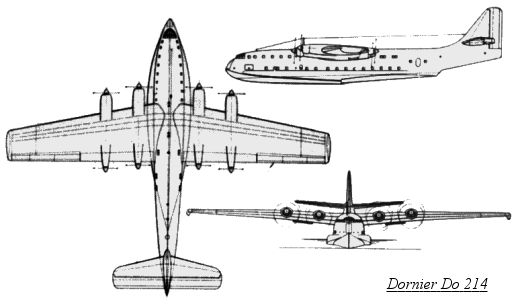 Originally designed as the Do P.93 for passenger transatlantic service
from Lisbon to New York, the Do 214 was redesigned as the P.192 for military
service. Instead of the usual Dornier fuselage stabilization floats, a
more aerodynamically refined design was to be used. Basically, long
bulges along the fuselage bottom were added. To test this new design,
the Göppingen Gö 8 was built in 1940 at Schempp-Hirth. Constructed
of wood with no engines, and built at a scale of 1:5, the Gö 8 was towed
by a motorboat to test the hydrodynamic stability of the new fuselage bulges.
The results were then sent to the Göppingen laboratories where the
details of the aerodynamic characteristics were also examined. After
receiving the results of the tests, the RLM issued the aircraft designation
214 to Dornier for this new flying boat. In 1941, a full-sized fuselage
mockup was begun to investigate the interior layout.
Originally designed as the Do P.93 for passenger transatlantic service
from Lisbon to New York, the Do 214 was redesigned as the P.192 for military
service. Instead of the usual Dornier fuselage stabilization floats, a
more aerodynamically refined design was to be used. Basically, long
bulges along the fuselage bottom were added. To test this new design,
the Göppingen Gö 8 was built in 1940 at Schempp-Hirth. Constructed
of wood with no engines, and built at a scale of 1:5, the Gö 8 was towed
by a motorboat to test the hydrodynamic stability of the new fuselage bulges.
The results were then sent to the Göppingen laboratories where the
details of the aerodynamic characteristics were also examined. After
receiving the results of the tests, the RLM issued the aircraft designation
214 to Dornier for this new flying boat. In 1941, a full-sized fuselage
mockup was begun to investigate the interior layout.
The Dornier
214 was a very large aircraft with a wingspan of 60 meters and a loaded
weight of 145 metric tons. The fuselage was streamlined and of a round
cross-section, with the interior consisting of two decks. Wings featuring
a small amount of sweepback on the leading edge, with straight trailing
edges were shoulder mounted on the fuselage, a common feature on seaplanes.
Eight Daimler Benz DB 613 24 cylinder piston engines provided the power,
with four engines pulling and four engines pushing. All eight engines were
driven by four-bladed VDM variable pitch propellers; the front propellers
had a 5.0 m (16' 5") diameter, the rear had a 4.6 m (15' 1") diameter.
The rear propellers were driven by an extension shaft and were also hinged,
which allowed the rear propellers to be raised during takeoff for water
clearance. This method was also used on the Dornier Do 26. Each engine
had its own coolant and oil systems and all eight engines were monitored
by a flight engineer from a central station. Fuel capacity consisted of
66000 liters (17435 gallons) in the fuselage and 1500 liters (396 gallons)
in the wings. A single fin and rudder was fitted, the tail planes were
of a conventional design. The civil aircraft crew consisted of twelve men,
which consisted of a captain, two pilots, navigator, radio operator, two
flight engineers, two stewards, two hostesses, and one crew member held
in reserve. In the civil version, forty passengers could be carried
in comfort, with the possibility of increasing the passenger load and 2.6
metric tons of freight and luggage could be carried in the lower fuselage
storage area. There were at least nine variants
of the Do P.192/Do 214 planned, with various defensive and offensive weapon
options.
In 1942 the
RLM criticized Dornier for working on the civilian version of the 214 and
ordered them to concentrate on the military version. The mockup was
reconstructed to investigate the best placement of the gun turrets and
other military stores. By 1943, it was realized that long-range flying
boats were not needed due to the worsening war situation, and thus the
Do 214 project was canceled.
Dornier Do P192/214 Data
| Span |
Length |
Height |
Wing
Area |
Empty
Weight |
Loaded
Weight |
Max.
Speed |
Cruising
Speed |
Landing
Speed |
Service
Ceiling |
Range |
60 m
196' 10" |
51.6 m
169' 4" |
14.3 m
46' 11" |
500 m²
5382 ft² |
76000 kg
167551 lbs |
145000 kg
319670 lbs |
490 km/h
304 mph |
425 km/h
264 mph |
155 km/h
96 mph |
7000 m
22966' |
6200 km
3853 miles |
| Dornier P.192/Do 214 Models |
| There are no models of the Dornier
P.192/Do 214 available at the present time |
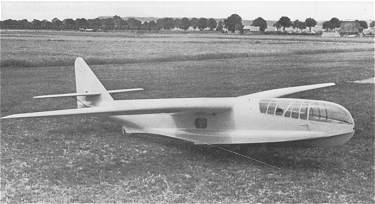
The Göppingen Gö 8 was a 1:5 scale model built
to investigate the newly designed fuselage bulges for the Do 214 seaplane.
It had a wingspan of 12 m (39' 4") and was built entirely of wood.
Wartime models of the Dornier Do 214
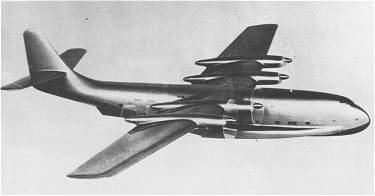 |
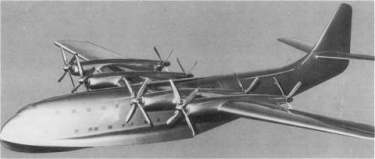 |
Gerd Heumann's impression of the
military version of the Do 214 in flight
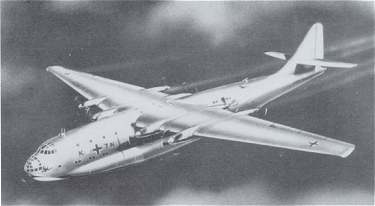 |
Proposed P.192 variants
| P.192.01 |
Transport w/33000 kg load
10 remote controlled gun stations. |
| P.192.02 |
333 personnel troop transport |
| P.192.03 |
Heavy cargo transport 82000 kg load |
| P.192.04 |
U-Boat supply aircraft |
| P.192.05 |
Aerial minelayer |
| P.192.06 |
Fuel transport and flying tanker |
| P.192.07 |
Military transport for fully armed
and equipped troops |
| P.192.08 |
Air ambulance |
| P.192.09 |
Long-range bomber and
guided weapons carrier |
|
Dornier Do 214 civil version
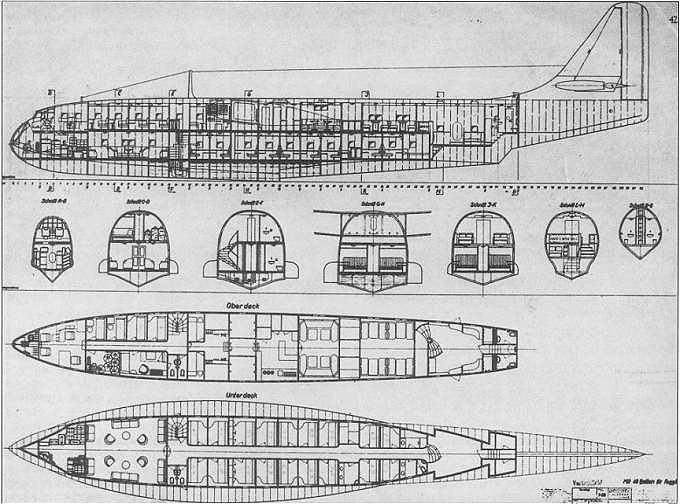

Dornier Do 214 military version
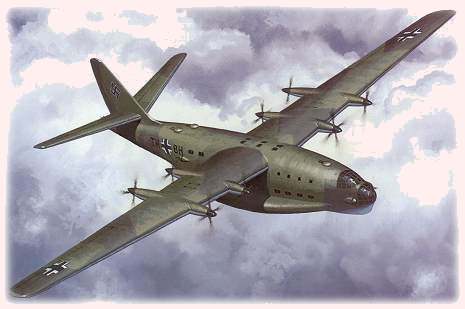
Left: Do 214 by Keith Woodcock,
from Monogram Monarch #2: Dornier 335

Right: Image from Luftwaffe Secret Projects: Strategic
Bombers 1935-1945


 Originally designed as the Do P.93 for passenger transatlantic service
from Lisbon to New York, the Do 214 was redesigned as the P.192 for military
service. Instead of the usual Dornier fuselage stabilization floats, a
more aerodynamically refined design was to be used. Basically, long
bulges along the fuselage bottom were added. To test this new design,
the Göppingen Gö 8 was built in 1940 at Schempp-Hirth. Constructed
of wood with no engines, and built at a scale of 1:5, the Gö 8 was towed
by a motorboat to test the hydrodynamic stability of the new fuselage bulges.
The results were then sent to the Göppingen laboratories where the
details of the aerodynamic characteristics were also examined. After
receiving the results of the tests, the RLM issued the aircraft designation
214 to Dornier for this new flying boat. In 1941, a full-sized fuselage
mockup was begun to investigate the interior layout.
Originally designed as the Do P.93 for passenger transatlantic service
from Lisbon to New York, the Do 214 was redesigned as the P.192 for military
service. Instead of the usual Dornier fuselage stabilization floats, a
more aerodynamically refined design was to be used. Basically, long
bulges along the fuselage bottom were added. To test this new design,
the Göppingen Gö 8 was built in 1940 at Schempp-Hirth. Constructed
of wood with no engines, and built at a scale of 1:5, the Gö 8 was towed
by a motorboat to test the hydrodynamic stability of the new fuselage bulges.
The results were then sent to the Göppingen laboratories where the
details of the aerodynamic characteristics were also examined. After
receiving the results of the tests, the RLM issued the aircraft designation
214 to Dornier for this new flying boat. In 1941, a full-sized fuselage
mockup was begun to investigate the interior layout.






